THE JOURNEY HOME
More than 140 years ago, Rosebud Sioux children traveled 1,500 miles to Pennsylvania. Their remains are home at last.
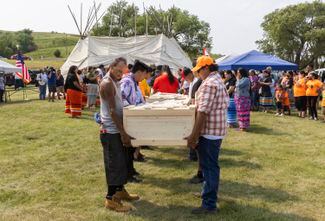
Four generations of relatives stood in the Missouri River at Whetstone Landing and allowed the waters to lap against their legs. Some dipped their fingers into the flowing waters hoping it would provide a connection to a relative who left South Dakota 142 years ago and died before ever returning.
This was where 16-year-old Dora, also known as Her Pipe, last said goodbye to her parents in October 1879 as she boarded a steamboat that would take her and 83 other students to a train for a 1,500-mile journey to the Carlisle Indian Industrial School at a vacant Army base in Pennsylvania. There they would be handed new names and military-style uniforms, shorn of their long braids, forced to speak English, and forbidden to practice their Native cultural and religious practices.
The water would not wash away the pain of the past. For Bernadine Red Bear, a fifth-generation descendant of Dora, there was no peace, only sadness. She knew from school records that the girl had been homesick and repeatedly asked to leave as she struggled with lung disease.
“She requested to come home in January 1881 because of her illness, but they didn’t let her come home.”


Dora’s request was finally granted this month, when she and eight other Rosebud Sioux children who died at Carlisle were returned to their homeland on a four-day trip that started July 14 and took them in a growing caravan of 400 vehicles through the Midwest to South Dakota, and became, for family and other tribe members, a time to reflect on heartache and intergenerational trauma at the same time they celebrated a homecoming.
Carlisle, the first U.S.-funded, off-reservation boarding school and the model for these types of schools across the country and Canada, had more than 8,000 students passing through, from its start in 1879 to its end in 1918, with the goal of changing Native American children “forever.”
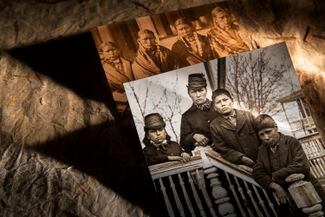
“They cannot escape [civilization] and must either conform to it or be crushed by it,” said Thomas Jefferson Morgan, the commissioner of Indian Affairs, in an 1889 speech.
Six of the students whose remains were claimed this month were part of the first class at Carlisle, and by 1882 were dead from diseases such as tuberculosis, pneumonia, and measles. The quick succession of Rosebud deaths put the future of the school at risk. In a letter to Chiefs White Thunder and Swift Bear, fathers of two Rosebud children, Ernest and Maud, the superintendent tried to explain the students’ passing on the same day in 1880. Following the death of another, Gertrude, also known as Stands and Laugh, Richard Henry Pratt wrote in September 1883: “In this connection it seems well to inform you that a strange fatality seems to hang over Rosebud pupils. Out of 101 we have had at the school since October 1879, 18 have died either at the school or since returning to the [reservation].”

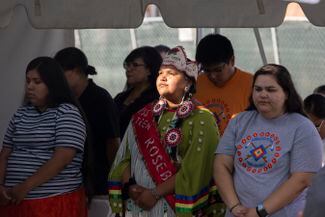
The homecoming
It was the Rosebud’s Sicangu Youth Council that started the repatriation process with Carlisle six years ago, and it would be members of the youth council to bring the children home — a van and trailer, instead of trains and a steamboat, as they tried to mirror the original 1879 trip in reverse. Along the way, Native communities invited them to stop so they could offer their prayers and join the celebration.
From Carlisle, they spent the night in Maumee, Ohio, and drove through to Tama, Iowa, before landing in Sioux City, in the early morning hours of their third day. There, council members were hugged and given a hero’s welcome at the same place where spectators turned out in 1879 to mock the children of the people who had defeated General Custer and the 7th Cavalry three years earlier.
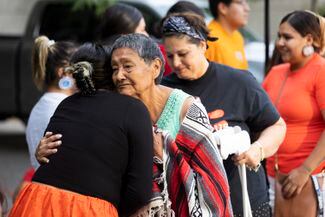
From there, a caravan of cars and motorcycles formed to escort the trailer through the rolling hills of Nebraska to the Santee Reservation in Niobrara, where people, signs, and donated toys lined the road near the Ohiya Casino.
Next they went north to South Dakota to the Yankton Sioux Reserve, where Duane Hollow Horn Bear, a descendant of one of the returning students, led the youth council members into the pow-wow grounds to be honored.
At Whetstone Landing, along the banks of the Missouri River, the caskets were removed from the trailer and taken into a council lodge to be with the descendants of the families they had said goodbye to more than a century before.

“We bring them here to touch the ground and for relatives to sit on the ground with them to be reunited,” explained Russell Eagle Bear.
The caravan, then more than a mile long, made its way west from the Missouri River through towns like Winner and Okreek, where Native and non-Native folks lined the roadway through small towns and rolling hillsides, many wearing orange shirts to commemorate the boarding school experience, raising fists and holding signs welcoming the students. Eventually, they made it to Mission and the Rosebud Sioux land.


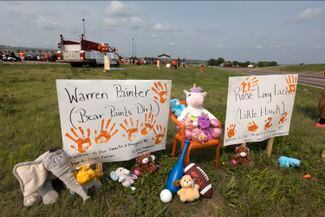
The night they arrived and into the next day, hundreds of people came for a wake inside the gym of Sinte Gleska University.
Afterward, eight of the students were laid to rest, six in Sicangu Akicita Owicahe, the Rosebud Sioux Tribe veterans cemetery, in White River, and two, Dora and Ernest, in private cemeteries. (A ninth child, Kola, nephew of Chief Hollow Horn Bear, was buried Tuesday.)
The remains had been prepared for reinterment back in Carlisle by Ione Quigley, Rosebud’s tribal historical preservation officer, having been wrapped in buffalo robes and placed in cedar boxes — instruction she learned from the late medicine man Leonard Crow Dog. “They never got to be what they were meant to be,” Quigley said of the children. “I realized these spirits were children that needed a mother, that needed a grandmother, and I will be that for them.”
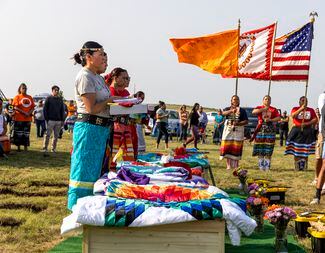
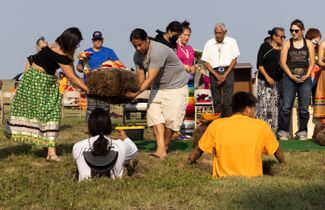

In South Dakota, the Lakota Women Warriors Color Guard stood at attention and the drumming and vocals of the Red Leaf Singers drifted over the surrounding hillsides, as the bundled remains were handed from one person to another who stood in the graves. Placed with the bundles were gifts provided by families and the tribe, a star quilt, and the soil from the graves in Carlisle so as to include any additional bone fragments.
The reburials brought some peace and closure. Still, said Bernadine, it “hurts to know what was done to the children in Carlisle and other boarding schools.
“It will hurt as long as I live.”

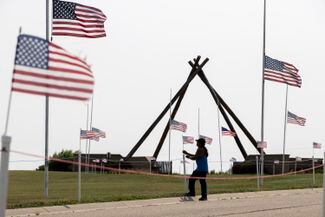
Staff Contributors
- Reporting: Charles Fox
- Design & Development: Dain Saint
- Editing: Cathy Rubin
- Visuals: Charles Fox, Danese Kenon
- Digital: Annie Bryan, Jessica Parks
- Social and distribution: Lauren Aguirre, Caryn Shaffer
- Copy editing: Rich Barron, Brian Leighton